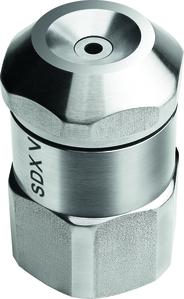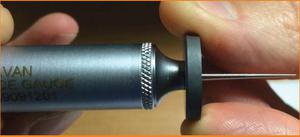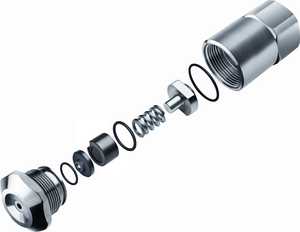SDX® Spray Drying Nozzles
Spray Drying Nozzles
The Quality you’ve come to expect
Delavan Spray Drying Nozzles reflect years of dedication to quality, flexibility and reliability. Since 1935, the Delavan name has become synonymous with precision engineering, proven techniques and product satisfaction. Today Delavan continues to be a leader in the spray drying industry by staying on the forefront of research and development in new materials, delivery systems and designs to handle new challenges across a range of industries. In 1957, Roger W. Tate joined Delavan as the Director of Research, and within a few years the eccentric spiral swirl chamber nozzle was born.
SDX® Range

This tradition started with the original SDX® Nozzle and continues with the latest SDX® family of nozzles. This product line, specifically designed for the spray drying industry, includes five centrifugal pressure nozzles: the Mini SDX®, Compact SDX®, SDX®, SDX® III, and SDX® V.
Each of these five products is built on Delavan’s unique single inlet spiral swirl chamber design and highly polished orifice. The combination of the swirl chamber and orifice produces a limitless number of combinations, to supply virtually any flow-rate and spray angle. This means the nozzle can be ‘fine-tuned’ to almost any dryer or application.
High Performance, Rugged Durability
The Delavan SDX® range of spray drying nozzles set the standard by which other nozzles are judged. We were the first to hold a patent on the revolutionary swirl chamber design, with a single inlet, which minimises plugging and maximises particle uniformity. This design has improved dry product quality, as the spiral configuration conforms to the natural path of liquid as it progresses toward the orifice.
Here at Delavan, when you talk we listen.
Delavan is continually evaluating the critical design features of the various models of nozzle that comprise the SDX® range. This engineering work, combined with feedback from thousands of users around the world, generates opportunities to improve the performance of the product as well as lowering the cost of ownership and simplifying maintenance. Significant recent enhancements to the SDX® range can be found within this updated product brochure.
An Investment in Quality and Performance
The substantial investment that Delavan has made in the last few years in state-of the- art machining centres has borne fruit in the improvements in quality and lead time reduction that have taken place since manufacturing was transferred to the centre of excellence for spray dry products at Widnes, in the UK. Combined with high technology laser marking and premium quality packaging this ensures that all genuine Delavan SDX® components reach customers in a timely fashion and in pristine condition.
Delavan remains committed to providing all customers with the reliable delivery of premium quality products, which offer the kind of performance and benefits expected from the nozzle technology leader.
WHAT WE OFFER

High Performance – Rugged Durability
Delavan offers:
- Durability and wear resistance
Our nozzles are available in materials that resist chemical attack such as plastics, ceramics, sintered carbides and various grades of stainless steel. - Customisation
To suit all your application needs, you can specify spray characteristics to meet your needs, including droplet size and particle size, spray angle, flow variation and properties of the liquid being sprayed. - Versatility
Delavan offers 3 swirl chamber configurations with orifice discs ranging in size from 0.4mm to 6.4mm. The large number of swirl chamber orifice combinations provide customers with more options when spray drying a variety of different products. Swirl chambers and orifices can be paired in a variety of combinations to produce the droplet size, flow rate, and spray angle and product quality needed to meet your exact product specifications. - Lifetime service and support. Once Delavan nozzles are installed in your dryer, the support never ends. You can contact Delavan at any time with changes, questions or issues.
- Computer Analysis – To suit all your application requirements, Delavan uses computer analysis programs to produce information such as droplet size, spray angle, flow rate – all this before installing any nozzles into the spray dryer, saving valuable time and money.
Our Technical support includes:
- Technical expertise and know how
Understanding the “custom” aspect of each application is of critical importance in spray drying. Almost every dryer presents a unique situation depending on feed material, capacity, and operating conditions. Delavan understands the conditions and problems inherent in spray drying and will recommend the right nozzle for the best performance. - Delavan’s application specialists are constantly working with end users and OEM’s globally to not only improve production processes and final powder quality, they are also working with operators to ensure alignment with our proven operating practices.

CRITICAL CARE AND MAINTENANCE

The perception within the industry is that nozzle bodies and adaptors will last indefinitely, however this is far from the truth and just as much attention needs to be given to the Bodies and Adaptors as is applied to the Orifice Discs and Swirl Chambers. Where the Orifice Disc and Swirl Chamber condition has a direct relationship to spray quality the Nozzle Body and Adaptor condition has a direct relationship to smooth operation and nozzle safety.
The Delavan SDX® nozzle range has been specifically designed for high pressure applications with the SDX® III configuration being in service throughout the world for over 40 years. Each component throughout the SDX® range is precision machined to tested and proven dimensions with close tolerances to suit the exacting requirements demanded by the process.

In order to ensure that the nozzles continue to operate effectively it is vital that each component is handled carefully, ensuring that there is no damage to the components. This is particularly important with the sealing surface areas and the threads. Any slight damage to a sealing face or surface, or to a thread profile, can potentially cause an issue. If there is any doubt about the condition of a component then Delavan would suggest that the item is replaced.
The Delavan SDX® range of nozzles has been operating successfully and safely throughout the world for over 60 years. In developing the SDX® range independent high pressure cycling and proof pressure testing was commissioned in order to ensure that we can support the ever increasing demands of our customers, complying with ASME B31.3 standard.
TRAINING
The Delavan SDX® range of nozzles are fully supported in the field through organised training sessions and backed up with decades of technical experience in spray drying. Delavan offers a maintenance and training program for operators and OEM’s to ensure that you have all of the tools necessary for trouble free operation of your spray nozzles.
 Some of the topics covered are:
Some of the topics covered are:
• Maintenance
• Assembly / disassembly
• Inspection of carbide components, the effects of wear and what to look out for
• Good practice guide
THE CRITICAL FACTORS THAT AFFECT SPRAY QUALITY
The Atomiser
Delavan recognises that at the ‘heart’ of any spray dryer is the atomiser, small in size, big in importance. Therefore installing the right atomiser is an essential step to ensuring spray drying success.

The atomiser must fulfil several important functions:
It must disperse the feed material into small droplets, which should be well distributed within the dryer and mixed thoroughly with the hot gas
The size of the droplets produced must be compatible with the required product particle size characteristics in order to function correctly
The droplets produced must not be so large that they are incompletely dried nor so small that product recovery is difficult – small particles may also overheat and become scorched if this is the case
The atomiser must also act as a metering device, controlling the flow rate at which the material is fed into the spray dryer
Consequently, the atomiser, though a relatively inexpensive component, is therefore an extremely critical element in the spray drying process.
Each SDX® product incorporates a single inlet design which enhances the nozzle’s performance by minimising plugging and maximising particle uniformity.
As standard the automated polishing process controls the diameter of each orifice to within +/- 0.001″ (0.025mm) and a highly polished surface ensures incomparable spray performance and durability. The key to the SDX® Nozzle’s success is its spray quality and uniform particle size, creating a narrow particle size distribution. The internal design atomizes liquids with viscosities up to several hundred centipoise. As you can see from the below images, the polishing of an orifice is essential in delivering an evenly distributed spray pattern.
Centrifugal Pressure Nozzles
The SDX® represents Delavan’s range of centrifugal spray drying nozzles. Energy for atomisation is supplied solely by the feed liquid pressure, with pressures up to 700 Bar being used. The SDX® range is of the swirl type configuration using a single inlet swirl chamber and has the capability of atomising liquids having viscosities up to several hundred centipoise. All the SDX® nozzles use a similar design swirl configuration with orifice discs, thereby guaranteeing uniformity of performance across the range.
Two-Fluid Nozzles
In two-fluid nozzles, gas (or steam) supplies most of the energy required to atomise the liquid. Liquid admitted under low pressure may be mixed either internally or externally with the gas. Although energy requirements for this atomiser are generally greater than the spinning disks or pressure nozzles, the two-fluid nozzle can produce very fine atomisation, particularly with viscous materials. It is often used in laboratory and small spray dryers.
Liquid Properties

The properties of the feed stock are directly related to the finished particle size. Therefore density, viscosity, percentage solids, abrasive awareness and any other characteristics all need to be considered. The liquid properties should be established at the temperature corresponding to the liquid in the nozzle. Feed stocks are often sprayed at elevated temperatures to decrease viscosity, thereby improving atomisation.
The effect of each liquid property on droplet size is usually established by actual test, however Delavan’s field experience shows that these effects can be closely estimated from the following correction factors:
Spray Quality and Particle Size
Whilst durability is one of the foremost requirements of pressure nozzles, atomisation quality is certainly just as critical. The importance of droplet size is often more critical than in other spray operations. Droplet size affects not only dryer size and operating efficiency, but also the characteristics of the final product. Particle size is critical with regard to bulk density, solubility and customer acceptance. Distinguishing between droplet size and particle size is important, since the two are generally not identical, although the relationship between the two can often be determined, usually by on-site trials. Particle size, or droplet size is usually expressed in terms of a mean or average diameter as well as the range or spread in size.
Droplet Diameters
Delavan uses the Sauter mean diameter, whose ratio of volume to surface area is equal to that of the aggregate spray, to measure the droplet diameter. The range or spread in droplet size requires an understanding of the entire distribution. Typically, a spray drying nozzle will produce droplets as small as 1-2 micron and as large as 400-500 micron. However, the majority will be within a range of 50- 200 micron. The narrower the range of droplet size the more suited it is to spray drying, with a ‘mono -range’ the ultimate goal for most operators.
Spray Angle
The spray angle in spray drying is usually in the 60° to 90° band. It must be noted that the spray angle measured near the orifice may not prevail further away. This is particularly true at high pressures, when the angle becomes actually narrower within a short distance. Therefore it is important to establish the exact manner in which this spray angle is measured.
Flow Variation
SDX® nozzles can also act as metering devices, controlling the distribution of feed into the chamber. Whether a single or multi-nozzle application, the flow rate must be precisely controlled to be compatible with the dryer design. It is important therefore to understand the properties of the feed material.
Wear Resistance
The wear life of the internal parts (consumable parts), depends upon its corrosion and erosion resistant characteristics
Corrosion occurs when the liquid feed and wear parts are chemically incompatible. Corrosion problems can be avoided if the chemical properties of the feed stock are known and the material of the consumable parts are designed to be compatible.
Erosion results from the liquid feed with its abrasive solids physically removing the material. Erosion can be combated, but never fully overcome. The use of harder material, or special materials can reduce this problem.
DUAL FLUID RANGE
The Delavan Swirl-Air™ range of spray nozzles, based on aerospace technology and developed within our Gas Turbine Division was designed to maximise hydraulic and pneumatic energy to atomize liquids at reliatively low pressures. Originally designed for use in evaporative cooling, spray drying and combustion, they have since been used in many other industrial applications from Food to Steel production. Different spray angles are available; flow rates can be changed by adjusting air and liquid pressure and the degree of atomization controlled by changes in the air-to-liquid volume ratio

Two installation configurations are available. In the right angle nozzle, atomising air enters the side and the liquid enters axially in the back. With the in-line nozzle, concentric piping is used with the liquid in the centre and atomising air entering around the outside. Concetric pipe adapter assemblies are optional and are not included with the nozzle assembly as standard.

